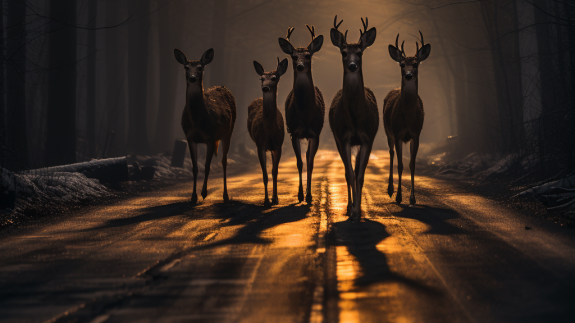
Navigating Fall Roads: Tips for Avoiding Deer Collisions
November 13, 2023: As autumn arrives, so does the challenge of sharing the roads with not only the changing weather but also the increased activity of deer during their mating season.
Daylight Saving Time changes contribute to reduced visibility during evening hours, making it crucial for drivers to exercise extra caution. Here are some practical tips to ensure your safety on the roads this fall:
Mind the Speed Limit: It might sound like common sense, but adhering to speed limits, especially in deer crossing zones and wooded areas, can significantly reduce the risk of collisions. Deer are most active during dawn and dusk, so slowing down during these times is particularly important.
Stay Alert and Vigilant: Be extra attentive when driving through areas known for deer populations. Look for deer crossing signs, and keep an eye out for movement along roadsides. Scan the road and its surroundings to detect any potential threats before they become immediate dangers.
Expect More Than One: Deer often travel in groups, so if you spot one crossing the road, be prepared for others to follow. Resist the urge to speed up once one has passed; instead, maintain a safe speed and keep a watchful eye for any additional deer that may be following behind.
Use Your Horn Wisely: If you find yourself in a situation where a deer is on or near the road, slow down and use your horn with one long blast. This can help frighten the deer away, preventing it from crossing further into your path. However, avoid excessive honking, as this may confuse or disorient the animal.
Dusk and Dawn Awareness: Deer are most active during dawn and dusk, periods when visibility is often compromised. Use your headlights wisely during these times, and be especially cautious in areas where the road is bordered by dense vegetation. Increased awareness during these low-light conditions can be a crucial factor in preventing collisions.
Stay Centered in Your Lane: While driving, stay centered in your lane, especially on roads bordered by woods or fields. This gives you more time to react if a deer suddenly appears. Avoid swerving into oncoming traffic or off the road to prevent more severe accidents.
Utilize High Beams When Appropriate: When driving in rural or sparsely populated areas, where the use of high beams won't blind oncoming drivers, switch to high beams. This can extend your field of vision and make it easier to spot deer from a greater distance.
Remain Calm After a Collision: In the unfortunate event of a collision with a deer, it's essential to stay calm. Do not attempt to touch the animal, as a frightened or injured deer may react unpredictably. Move your vehicle off the road if possible, turn on your hazard lights, and call 911 for assistance.
By incorporating these tips into your fall driving routine, you can significantly reduce the likelihood of a collision with deer. Remember, staying vigilant, slowing down, and being prepared for the unexpected are key elements in ensuring a safe and enjoyable journey through the beautiful but potentially hazardous fall roads.
WNCTimes
Image Credit: WNCTimes


 How to resolve AdBlock issue?
How to resolve AdBlock issue? 